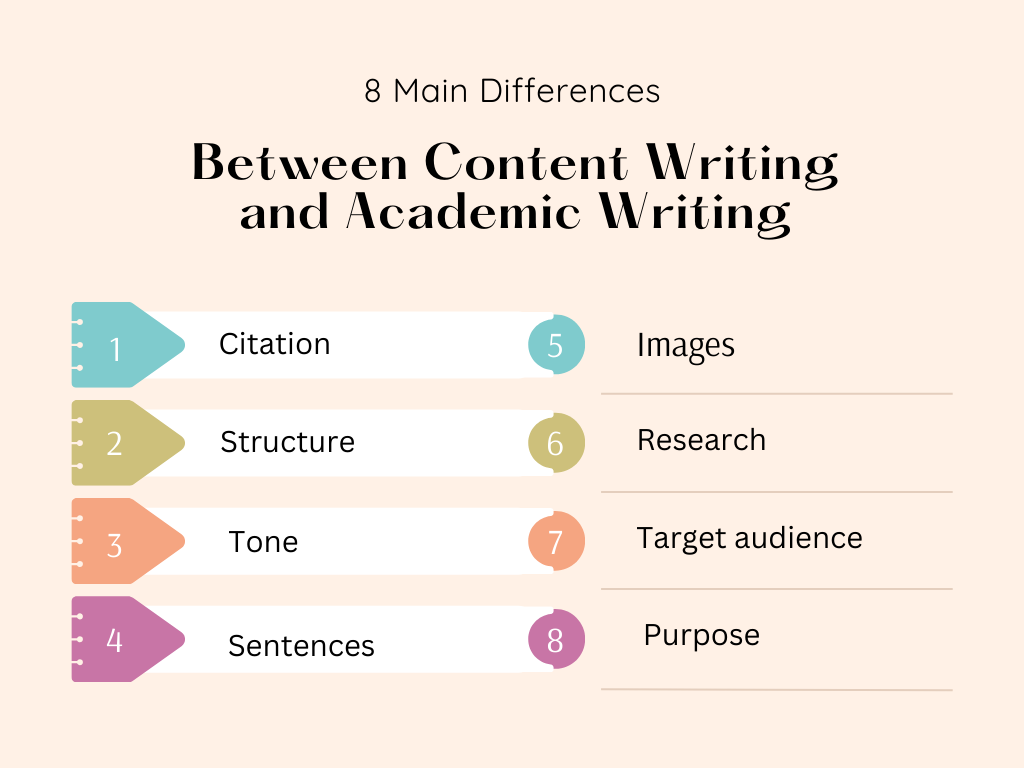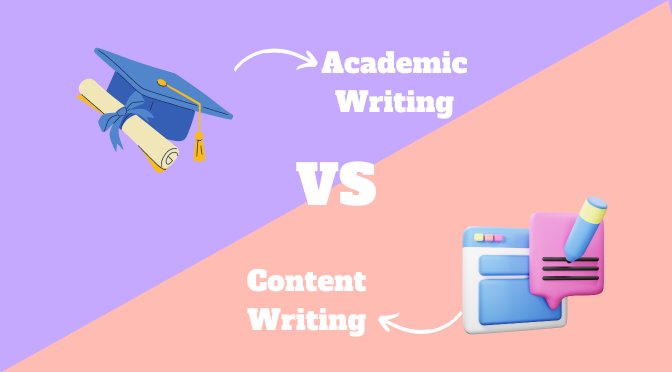Writing comes in many flavours, and two of the most common ones are content writing and academic writing. Often, people get confused when they are using one form or the other.
For example, if you’ve ever written a professional email and then texted a friend, you’ve already experienced using different forms of writing. The professional tone in emails and the informal, conversational style in text messages represent two distinct writing styles.
Still confused?
Sit back and relax as we help you discover the key differences between these styles.
What is academic writing?
Academic writing mainly involves writing reports, papers or essays focusing on research data. The purpose is not to promote or entertain the readers. But to convey scholarly information to a small group of qualified audiences.
What is content writing?
Content writing is mainly done for websites, blogs or other online media. The purpose of content writing is to promote a website or a business to a comparatively large set of audiences. Another aim of web content is to help a site rank better in search results.
The differences
Here are the key differences between academic writing and content writing.

1. Citation
An academic writing needs to have references. It is very important to use proper citation for any data used. There are different rules on how to cite a source.
A regular content may also use data and references. But here the data validation rules are not strict. A hyperlink is good enough to point to a reference.
2. Structure
An academic article has a very well-defined structure. General content writing does not need to be that systematic. Depending on the topic and purpose, content can have any shape or form.
3. Tone
Academic or scholarly writing is formal in nature. It is not supposed to have a personal tone. Sentences cannot be ambiguous. Each sentence should have a clear meaning and purpose. Academic articles are not a good place to express personal opinions.
Web content is usually informal. A personal tone is appreciated here. However, each website has its own brand voice. And the contents of the website should reflect that.
It may not seem easy to follow distinctive academic and content writing styles. However, with the help of a paraphraser, you can easily convert your writing style into a specific tone. By using a paraphrasing tool, you can do the following things:
- Get rid of plagiarism.
- Makes the content more engaging.
- Improves readability.
4. Sentences
Short sentences are ideal for content. It makes them easy to read and understand. But they are not always good at academic writing.
Staying away from ambiguity is more important in scholarly works. Complex sentences are often used in that regard.
5. Images
Academic writing may require images. These images complement the central idea presented in the article. No image is used for decorative purposes. And each image must be accurate.
In content writing, images serve several purposes. One is to grab the attention of the reader. Images make the article more presentable. They help the writer illustrate their key points. Most of the articles on the web also have a featured image.
6. Research
Academic writing demands comprehensive research and involves reviewing a wide range of sources in terms of supporting arguments, exploring a new topic or presenting new findings. Even sometimes it involves conducting original research such as experiments, studies or surveys.
On contrary, content writing involves researching but not as exhaustive in academic writing. And the research is focused on practical sources such as online articles, statistical data, expert interviews or specific reports.
7. Target audience
The target audience for academic writing includes students, researchers, scholars and professionals who are experts in a specific field and have a deep understanding of the subject matter. This allows for the use of in-depth discussion, technical terminology, theories and methodologies in the writing.
Content writing usually targets a broader audience including the general public, potential customers or consumers. Hence the content needs to be accessible and understandable enough for people without specialised knowledge as well.
8. Purpose
The primary purpose of academic writing is to contribute to the body of knowledge that involve presenting new research findings, developing theories or advancing scholarly discussions. It eventually encourages analysis, debate and intellectual growth within the academic community.
On the other hand, the main purpose of content writing is to entertain, inform and engage the audience, be it to educate readers about a topic or to promote a product or service or to encourage a specific action.
Are there any similarities?

Yes, despite the difference, both academic writing and content writing do share many similarities. For example, in terms of clarity and precision, both academic and content writing need to communicate ideas clearly to make their points understandable to their targeted audiences and convey their message accurately. Also, both writing style rely on research to support their claims while following a structured approach to present information.
Both writing follow ethical standards to maintain credibility and integrity. Academic writers need to site sources properly to give credit to original authors to avoid plagiarism. Similarly, content writers need to ensure that their work is original and properly attribute sources when using information.
All these similarities portray how both types of writing need careful research and clear communication, even though they’re used for different purposes and in different ways.
Can you switch between the two writing styles?
Even though it may seem challenging, it can be achieved smoothly by following only a few tips.
Understand your audience: Modify your language and tone to match your audience’s preferences. As an example, for your younger readers, you can use a casual and engaging tone instead of a formal, academic style.
Relevant read: Why Brands Should Invest in Content Moderation Services?
Maintain focus: Keep your end goal in mind to make sure the style change is purposeful and effective. This will help you to avoid unnecessary rambling and keeps your writing clear and impactful.
Prioritise SEO: Utilise off-page SEO tools and optimisation software to ensure your content reaches the right audience. This enhances visibility and ensures your work gets the recognition it deserves.
Seek feedback: Regularly ask for feedback from skilled writers and members of your target audience in order to filter your writing style and make necessary adjustments to improve overall quality.
Practice and experiment: Regularly practice and experiment with different styles to make transitions smoother over time. Don’t be afraid to try new approaches and learn from the outcomes.
Final words
Academic writing is a completely different thing from everyday writing. You need to be a subject expert or at least need to do some deep methodical research to write academic content.
General contents do not require that much formal research. But it never means it is easy to write high-quality web content, either. Making an article readable, interesting and marketable is quite difficult. No matter what type of content you write, you need to put in a lot of time and effort to succeed.



